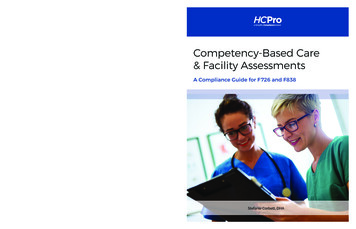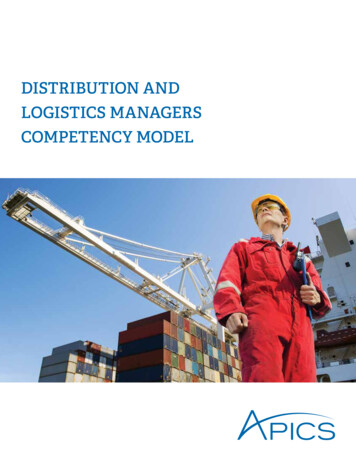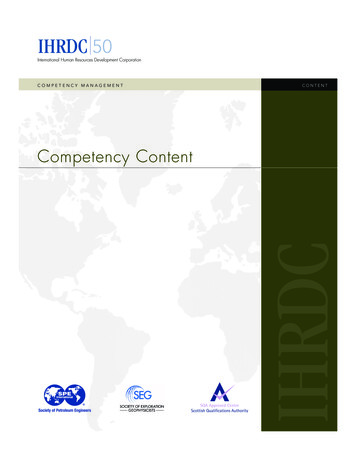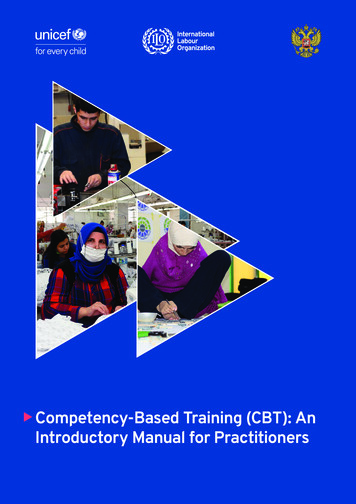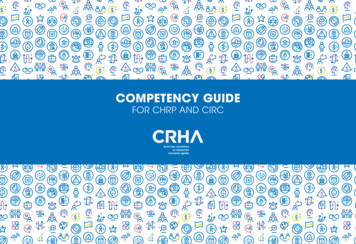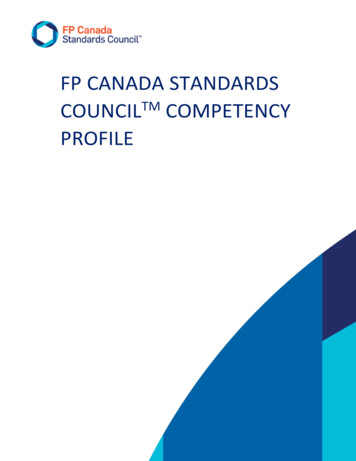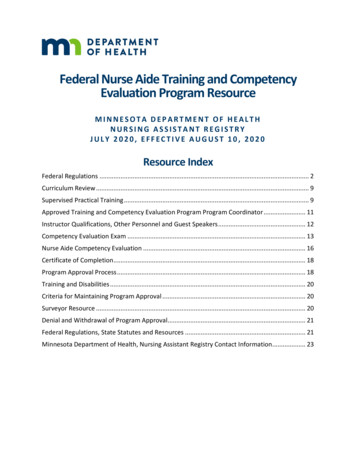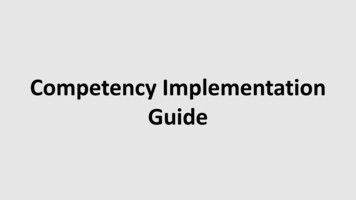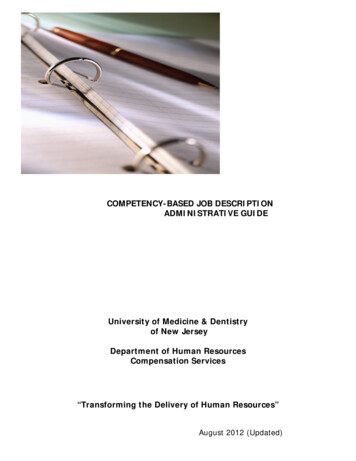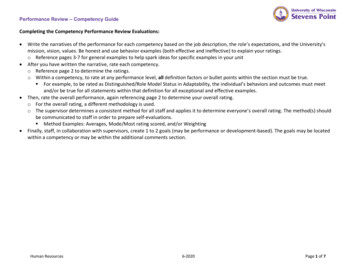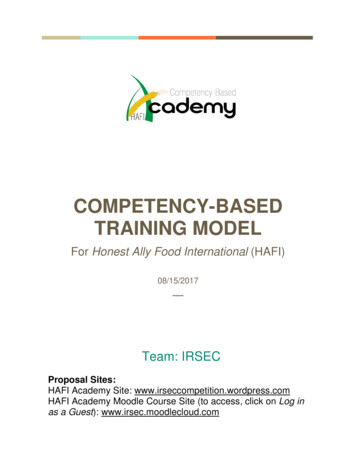
Transcription
COMPETENCY-BASEDTRAINING MODELFor Honest Ally Food International (HAFI)08/15/2017 Team: IRSECProposal Sites:HAFI Academy Site: www.irseccompetition.wordpress.comHAFI Academy Moodle Course Site (to access, click on Log inas a Guest): www.irsec.moodlecloud.com
1Proposal SummaryFood insecurity is a global issue that has a bigger impact on developing countries, particularlyamong African nations (Smith, Obeid, & Jensen, 2000). It is also a complex, multi-faceted andsystemic challenge (e.g., see Fig 1) that cannot be resolved by a simple one-size-fits-all solution.Instead, it requires a concerted effort that includes not only the provision of food sources or aswitch to sustainable resources, but also well trained and competent staff capable of analyzingand acting on situations and helping those in need without bias or prejudice to build the capacitywithin communities (Elvidge, 2017).Figure 1. Conceptual framework for food security (Smith et al., 2000)An international NGO Honest Ally Food International (HAFI) expressed the need for trainingnew and current employees, volunteers, and the community to fight food insecurity. lecloud.com
2continually support staff and help them develop the capacity to assist communities, we introducethe HAFI Academy, a competency-based training and staff development program. The followinggoal has been identified and expanded:1. Promotes and aligns with HAFI mission and vision2. Consistent, culturally sensitive and meets the diverse needs of new and currentemployees, volunteers, community, and organization3. Scalable from one location (Nigeria) to 200 partner organizations across the globe4. Accessible online5. Maintained locally by HAFI employees6. The staff will work with the talent coaches to identify the needs and gaps using PriorLearning Assessment, and determine the pathways to bridge these gaps. Onceestablished, the HAFI Academy will be sustainable and run by the local trainers andcoaches.OverviewKey TermsCompetency-Based Training (CBT): CBT is outcome-based and assesses learners’ attainmentof competencies determining whether learners demonstrate their ability to do something (Cleary,2015).Competency: Competency refers to the description of measurable knowledge, skills, abilities,and attitudes (KSAAs) that could be attained by learners (Koenen, Dochy, & Berghmans, moodlecloud.com
3Digital Badge: “A digital badge is a representation of an accomplishment, interest or affiliationthat is visual, available online, and contains metadata including links that help explain thecontext, meaning, process and result of an activity" (Gibson et al., 2015, p.405).Prior Learning Assessment (PLA): PLA is a flexible way of identifying, documenting, andgaining recognition for the prior learning (Canadian Association for Prior Learning Assessment,n.d.). The learning may occur in either formal or informal settings. In this proposed training,PLA will be used (1) to identify the training needs for each individual and (2) to validatetrainee’s previous learning occurred either in the workplace or formal education.Why the HAFI Academy?Talent is the key asset of an organization and should be part of the organizational businessstrategy. We recommend a stronger focus on talent development through an internal group - theHAFI Academy - that would allow for a single access to training and talent developmentservices that can help employees and volunteers achieve their potential and help those in needaround the globe.The HAFI Academy will empower HAFI employees, volunteers, and the community in thefollowing ways: A comprehensive online training and evaluation program using the competencyframework to meet the needs of the organization and its talent; Building community capacity to share more opportunities and access to food Increasing in the level of knowledge and skills, and improve abilities and attitudes tocontinue advancing HAFI services worldwide. Support the mission and vision of the organization through ongoing training andprofessional irsec.moodlecloud.com
4We have developed a sample HAFI Academy website to illustrate PR and work with futurelearners. Additionally, a sample logo was created to unite all the materials under the HAFIAcademy umbrella.Competency-Based Online Training ModelTo meet the goal, we propose to develop and implement a CBT model. CBT is a systematicapproach that Focuses on the competencies (i.e., knowledge, skills, abilities, and attitudes - KSAAs)essential for specific job titles, Requires trainees to demonstrate mastery of competencies, Monitors trainees’ progress and allows adjustments based on individual trainee’s needs(e.g. additional time, different competencies to be attained; Blank, 1982).The CBT model is performance-based with specific and measurable standards, yet it is alsolearner-driven, which means employees who demonstrate competency in one area do not need tocomplete training module in that area in order to demonstrate their proficiency.CBT will be more effective to meet the goal, set out by HAFI, than traditional training programs,because it allows to: Make job-related competencies a focal point of learning. Distinguish and learn from top performers within the organization to reflect explicit andtacit knowledge base. Track employee and volunteer progress. Embed organizational objectives and strategies into the learning experiences (Campionet al., moodlecloud.com
5 Achieve mastery of learning via robust assessment and badges. This will ensure thespecified proficiency that goes beyond limited retention of knowledge after a traditionaltraining. Make the learning process more personalized and/or individualized while providing theflexibility of learning and competency achievement paths Create a flexible and scalable model to support trainee proficiency across organizations(Koenen et al., 2015).Figure 2. Advantages of CBTCBT Model Design:In the model, competencies will serve as building blocks of professional growth, rooted in theneeds of the organization’s mission and vision. We envision three types of competencies (seeFig. dlecloud.com
6 Core competencies: the upper level competencies that are applicable and key for new andcurrent employees, as well as volunteers. They will ensure a common understanding anddevelopment of the knowledge and skills that can help with the promotion of the missionand vision of the organization. Job-specific competencies: to help new employees, current employees, and volunteers beprepared for their job. In addition, they can be used by those willing to gain newknowledge and skills outside of their current position. Community-specific competencies: These are basic competencies to support communitydevelopment targeted at understanding the organization and to attain skills aligned withthe mission and vision of the organization.Competency attainment: All employees and volunteers are to attain these competencies eitherby taking online training, engaging in an apprenticeship, or completing PLA to confirmequivalent proficiency. Those who show proficiency per the competency definition will begranted a digital badge with embedded metadata that would reflect the competency and rubricwith comments and feedback. Successful completion of training modules by the community willallow them to gain an award badge (equivalent to a certificate of irsec.moodlecloud.com
7Figure 3. Competency-based training oodlecloud.com
8Development of the CBT Model and Online Training (Input andOutput Phases):Adult Learning Principles: Andragogy, developed by Knowles (1968), is defined as “the artand science of helping adults learn” (Knowles, 1980, p. 43). In the proposed training, we willcover six conditions for learning proposed by Knowles (1980). Additional information on theapplication will also be provided in Section III Design Phase:1. Principle: Using learner’s experience as a resourceDescription: Adults can bring different life situations and perspectives which are rich forlearning. Adults also need to connect their learning with their current knowledge and previousexperiences. Thus, these authentic learning activities should be relevant to them.Application: In our training, trainees will reflect on their learning in their current practices (workand community application). Trainees will be encouraged to discuss how the new knowledge fitsinto what they already know, as well as what is new and how they can adapt the new knowledgeinto their existing knowledge.2. Create climate that encourages and supports learning:Description: Trustworthiness and mutual respect are the key principles of adult learningenvironments. To create a positive atmosphere to encourage learners to interact with each other.However, it does not mean that there should not be any conflict; it means even though there is aconflict, facilitators need to help learners acquire different perspectives and support them in theirefforts to do so.Application: In our training, learners will be asked to actively participate in discussions on topicsthat may be sensitive to some (e.g., juxtaposition of own culture with the culture of others in theIntercultural and Global Competency). Healthy debate on each topic will be encouraged .moodlecloud.com
9the use of group emails and feedback from trainers. Learners will be also provided with thenetiquette rules (e.g., see the Moodle course). In addition, we want local trainers to be trained inorder help develop trust within the organization and training itself.3. Adults need to know why they need to learn something before learning it.Description: Adults are motivated to learn by the need to solve problems. In order to engagelearners, it is important to address how given learning activities address the individual's andorganization’s goals, and assist trainees to fulfill their job responsibilities.Application: In the proposed training, in each module, an introduction video or case will beprovided explaining the importance of the given competency. Furthermore, across the trainingofferings, bringing up alignment with their current positions will be encouraged.4. Learners’ involvement in planning and implementation of learning activitiesDescription: Adult education is most effective when it is experience-oriented and relevant to thelearners’ needs. The learners accept a share of the responsibility for planning and operating alearning experience, and therefore have a feeling of commitment toward it. Involving learnersfrom planning to evaluation of the adult education program is also critical to motivate adultlearners and increase the relevance of training.Application: In the proposed training, learners’ involvement will start with gap analysis andcontinue through evaluation. On an individual training level, satisfaction instruments will be inplace to continue with the training improvement efforts.5. Interaction and CollaborationDescription: Learners can construct their own knowledge in interaction and collaboration withothers (Vygotsky, 1978). Additional emphasis will be on the roles of culture in the c.moodlecloud.com
10process, where cultural context impacts individual knowledge construction. Individuals will alsolearn and change their behavior as a result of observing what others are doing (Bandura, 1986).Application: In the proposed training, trainees will construct their own knowledge through thecollaboration, interaction with others, and experiencing others’ points of view (e.g., discussions,Wiki, and peer feedback).6. Cultivate self-directionDescription: Adults are self-directed learners. However, it is important to consider adult’sprevious experience, prior knowledge, and readiness.Application: In the proposed training, learners’ will provide their perceptions about a given topicin discussion forums, which will also allow them to seek input from other participants. Inaddition to the core modules, supplementary self-paced modules will be available based on atrainees’ interest and needs. Furthermore, self-reflections will be a part of the assessment toallow learners to reflect their own learning and help them diagnose the gap between their goalsand their present level of performance.In addition to the adult learning principles, the following considerations are embedded into thetraining based on Arousal, Expectancy-Value, Self-Determination, Goal-Setting, Flow, SocialCognitive and Constructivist theories:1. Provision of clear and constructive feedback at each junction of the module andexercises, learners will be informed on how they are doing and whether they are on task,additional points to consider, as well as the level of their collaboration with others andhow they can improve it. Additionally, the feedback opportunities will be used to providepositive reinforcement (e.g., praise) to learners by highlighting strong areas of www.irsec.moodlecloud.com
112. Tasks, activities, and materials are designed to raise curiosity, be challenging, butyet be attainable, which is achieved both with the design of tasks themselves andquestions asked, as well as due to the individualization of tasks and asking learners toexplore their own interests.3. Goals are clear and specific, which is achieved by a clear introduction to the module,learning objectives, as well as competency alignment embedded into the training.4. Transition of choice and control over the individual activities and overall learningpathways to learners, which is achieved by allowing a degree of choice of the portion ofthe activities to complete without losing the overall focus or value of the training.5. Focus on individual improvement, progress, and mastery of skills, which is achievedthrough the competency mapping and badges. Additionally, they can select learningpathways that are related to their jobs.6. Provision of supports/scaffolding as necessary: Since the needs in scaffolding dependon each learner, the scaffolding is available in the training in terms of resources, officehours, and opportunities to ask questions of the trainers and peers. However, the trainingis flexible enough that if a need arises, additional resources can be pulled in.Development of the CBT Model and Online Training (Input andOutput Phases):The development of the CBT model and online training to support employee and volunteerlearning is represented in the Logic Model (available on the HAFI Academy Website). Theinitial model (see Fig 4) will be to meet the needs of the Nigerian branch and will be scaled up tomeet needs of other offices and partner organizations across the moodlecloud.com
12The general description of the population and technological environment to support thetraining design are included in the logic model.Figure. 4. Project Logic ModelTimeline MilestonesI.Project Kick-Off (Prior to Project Start)Presentation of the project to upper management to ensure buy-in and identify achampion, who will help remove any roadblocks during project implementation.II.Exploration Phase (January -March 2018)This phase focuses on determining the characteristics of learners, identifying anddetermining competencies through job analysis, determining the learning goals for thetraining through gap analysis and odlecloud.com
13In-Depth Learner Analysis:Implementation and analysis of the following data: focus group and survey with topperformers and administrators, document review including employee’s job satisfactionand feedback results from previous clients and stakeholder.Job Analysis:Information collection about the job and organization’s situation to determine thebehavioral dimensions (i.e. competency proficiency) to be improved (InternationalTaskforce on Assessment Center Guidelines, 2015; Thornton & Rupp, 2005). Jobdescriptions and interviews with top performers and supervisors will be used for datacollection.Competency Identification and Definition:Based on the data above, competencies for each group of trainees will be identified anddefined. These competencies will include both core that are mandatory for all trainees(e.g. communication, problem solving, cultural sensitivity) and job-specific competenciesspecific to the job context. Next, competency statements/behavioral indicators for eachcompetency will be defined.Gap Analysis:To determine the learning goals for the training, gap analysis will be conducted. Table 1below provides a structure to gain more information about organizational (HAFI) goalsand needs in order to identity to direct learning and non-learning w.irsec.moodlecloud.com
14Table 1.Gap Analysis titudeBehavior / AbilityPrior Learning Assessment:We will utilize a PLA to (1) identify the training needs for each individual and (2)validate trainee’s previous learning occurred either in the workplace or formal education.Reviewing Existing Training:Since there is existing training available for the current employees, we plan to reviewexisting training to determine its strengths, challenges, and potential adaptations needed(if any). This will also inform design considerations.III.Design Phase and User Testing (April-November 2018)The training design and apprenticeship considerations will be aligned with competencybehavioral indicators. The training (including activities, assessment, and badge design)will be developed and deployed by phases: Phase I: Core competencies (up to 6 /-1) Phase II: Job-specific competencies. The priority will be given to those that havemore job coverage across positions (up to 10 /-2). Additional competencies willbe discussed as needed. Phase III: Community-specific .irsec.moodlecloud.com
15Considering the scope of the project, the principles of rapid prototyping will be utilized toensure timely completion of the project, e.g., Phase II will be designed and developedwhile Phase I undergoes user testing and modifications.Design Aspects of the Proposed TrainingEach online module will cover a competency. Each module begins with an “Introductionand Learning Objectives” which will provide an overview of expectations for a particularmodule. Each module includes video and reading resources, active learning activities(i.e., discussions, exploratory activities), and assessment (i.e., discussion, reflection, andcase studies). Many of the activities ask learners to consider and/or reflect on their ownpersonal experiences and how new learning could apply to them.Aspects of proposed training are derived from the adult learning principles andmotivational considerations presented in the “Development of the CBT Model andOnline Training” section.Social interaction aspects are for the collaborative modules, where knowledge coconstruction is dependent on social learning (e.g., Intercultural and Global Competency).For the self-paced modules, there will not be interaction aspect.IntroductionIntroduction includes definition of the given competency and learning objectives aligningwith competency indicators and descriptions (see Figure 5 for an examplemodule introduction. Click here to visit the Moodle course moodlecloud.com
16Figure 5. Example module introductionModule ResourcesEach module will include video and reading resources aligning with the objectives thatare aimed to raise awareness and help acquire the needed knowledge, as well as initiate acritical review of the information and own understanding and biases that will be furtherdelved into in active learning activities.Video Resources: Video resources will cover the importance of a given competency andexplain the subject related to the competency. The video lectures will include closedcaption to improve accessibility. In addition, video lectures will be broken into severalparts (microlearning) to allow for better focus and retention as well as to fit into the busyschedule of employees, who may not otherwise have large time periods to focus on thetraining. Additionally, to avoid passive intake of materials, the lecture will incorporateinteractive activities, e.g., built-in questions that need to be answered before sec.moodlecloud.com
17to the next section that will help learners check their understanding and engage in criticalthinking about the materials.For example, in the intercultural and global communication module, we will create avideo lecture similar to the Intercultural Communication presentation(https://www.youtube.com/watch?v SkBXaKfxl7Y). This video lecture will cover thedefinition of culture, words representing culture, and visible and invisible elements ofculture.Reading Resources: Related readings about a given competency will be provided.Active Learning ActivitiesLearning activities will be learner-centered and help learners master each task. Learnerswill construct their own knowledge through the collaboration, interaction with others, andexperiencing others’ points of view (e.g., discussions, Wiki, and peer feedback). Mainlearning activities will include:Discussions: Throughout the training, learners will be encouraged to participate intopical discussions aligned with the goal and objectives of the module and thecompetency description. Participants will be asked not only to post their initial thoughtsand respond to at least two other learners, but to maintain the spirit of ongoingdiscussion, they will also be asked to respond to comments left to their original post.For example, as seen in the Figure 6 (see the Moodle course site), intercultural and globalcommunication competency module will include two main discussions: icebreakeractivity and definition of culture discussion moodlecloud.com
18Figure 6. Example module discussionExploratory activities: These self-reflective activities will include job-related illstructured simulation exercises (e.g., leaderless group discussions, role playing activities)and ask learners to consider their personal experiences to solve ill-structured problems.Then learners will reflect on their personal experiences and how new learning couldapply to them.For example, in the intercultural and global communication module, learners will beprovided multiple parts (i.e., religion, education, marital status, etc.) of a culture and willbe asked to identify the parts of who they are. Reflection questions may include how didyou learned about cultural rules of these parts, which of these parts do you consider themost important, why, and which ones do you perceive to have an impact in yoursocial/educational/work environment in your country of origin (see the Moodle site).AssessmentThe focus will be on assessment for learning rather than assessment of learning. Differentassessment methods, including self-assessment, peer assessment, and performance-basedassessment will be oodlecloud.com
19Assessments will include case studies, peer evaluation through discussion forums andgroup activities, and self-evaluation through self-reflection.Discussions: For each discussion, learners will be requested to post an initial post andrespond to at least two of the peers. The posts will be evaluated on their integration of thecourse materials and own experiences, as well as engagement with their peers.Case studies: Throughout the training, trainees will be exposed to real-life case studies toallow them to explore what they have learned, analyze situations, and offer solutions thattake into considerations the intercultural and global competency principles. Some of thecase studies will be in print, while others may be video. Additionally, learners may beasked to use media platforms (e.g., YouTube or other ones available locally) to findvideos that represent the topic.For example, as seen in Figure 7 (see the Moodle course site) , one such case study mayrequire trainees to use their cultural KSAAs to analyze cultural clues and use empathy toview a dialogue between two people from the point of view of different cultures andpotential biases and misunderstanding. Finally, they will be asked to interpret theirexperiences with others from a different culture.Figure 7. Example case oodlecloud.com
20Reflections: This type of assessment asks learners to reflect on their own learning to helpthem diagnose the gap between their goals and their present level of performance.For example, as seen in the Figure 8, in intercultural and global communication module,cultural identity assessment aims to increase awareness of a learners’ own and others’cultural values and orientations. Trainees will be provided a number of questions relatedto various elements of culture. They will be asked to answer those questions, and askthose questions to another person from a different background (e.g., sub-cultures,ethnicity, religion, etc.). Then they will write reflection about what did they learn, if thereis any “aha” moments, how they could be apply their learning to their workplace, and theperceived challenges.Figure 8. Example reflection assessmentAssessment ToolsBehaviorally Anchored Rating Scale (BARS): BARS are a type of performance ratingscale that features performance measurement based on specific behavioral indicators atanchored scale points (Smith & Kendall, 1963). In the proposed training, BARS will beused to measure observed trainee practices during training to evaluate and providefeedback about their performance, facilitate decisions concerning what needs to beimproved, and determine individual trainee’s needs for further support. BARS will bedeveloped based on the competencies and behavioral indicators. A BARS example dlecloud.com
21intercultural and global communication competency is available on the HAFI Academysite.Digital Badges: A digital badge is a representation of an accomplishment, interest oraffiliation that is visual, available online, and contains metadata including links that helpexplain the context, meaning, process and result of an activity" (Gibson et al., 2015,p.405). Digital badges will be used for micro-credentialing, which indicates capturing,showcasing, and legitimizing competencies within individualized learning paths, andvalidating experiences, KSAAs, and achievements.FeedbackFeedback will be provided through three channels: facilitator/subject matter expert, peer,and self. Trainees will receive both just-in-time and detailed feedback on theirperformance to inform them “How did they do?” “Where are they?” and “How to moveforward?”AccessibilityThe following considerations will be given in terms of the training accessibility to ensurean equal access to all the HAFI staff, volunteers, and community (Accessibility Oz, n.d.;VITA), including but not limited to: Modules do not rely on a single sense or ability (e.g., only visual) Navigation is accessible, consistent, and does not rely on color (e.g., click onarrow vs. click green arrow) Online help or instructions available Module map (or sitemap) is available Closed-captioning for video/audio is available Interactive elements are sec.moodlecloud.com
22 Colors and contrast are appropriateCollaboration with an LMS programmer may be needed to ensure the full accessibility of thetraining.IV. ImplementationThis phase focuses on the implementation of the training. Section III explains the design aspectsby providing examples from the intercultural and global communication competency module.This section will be further detailed depending on the gap analysis results and HAFI’spreferences.Before the implementation training, facilitator(s) will be selected and trained according to keyaspects of the facilitation process. Facilitators will be knowledgeable and credible about thecompetencies to be developed.V. EvaluationKirkpatrick’s model will be used to evaluate the effectiveness of training. Table 2 summarizesthe levels and data sources.Table 2: Four levels of evaluation of the training effectivenessCriteriaSample InstrumentsParticipant’s reaction focuses on trainee satisfaction with Questionnairesthe training and training aspects. Participants’ evaluations ofTimeline: immediately upon completion of each set oftraining (click here for anmodulesexample on the oodlecloud.com
23Participant’s learning focuses on measuring the extent to Pre- and post- testswhich trainee changed attitudes, improved knowledge, and Personal reflections (seegained skills as a result of participating in the training.example reflections above)Timeline: Before and after the module sets.Behavior criteria includes measures of whether trainees Questionnairesused their new knowledge and skills on the job. ReflectionsTimeline: Three to eight months after the training. Analyzing organizationalResults / Organizational impact and change addresseswhether or not change was aligned with the organization’srecordsmission, individuals were supported and engaged at all levels Follow-up meetingsof the training, the training or activities impacted the Questionnairesorganizational climate, and sufficient resource
Competency-Based Online Training Model: To meet the goal, we propose to develop and implement a : CBT mode: l. CBT is a systematic approach that Focuses on the : competencies (i.e., knowledge, skills, abilities, and attitudes - KSAAs) essential for specific job titles,
